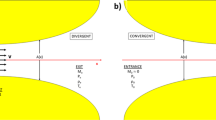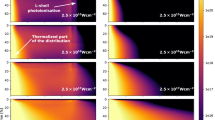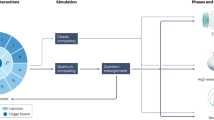Abstract
Relativistic kinetic theory is ubiquitous to several fields of modern physics, finding application at large scales in systems in astrophysical contexts, all of the way down to subnuclear scales and into the realm of quark–gluon plasmas. This motivates the quest for powerful and efficient computational methods that are able to accurately study fluid dynamics in the relativistic regime as well as the transition to beyond hydrodynamics—in principle all of the way down to ballistic regimes. We present a family of relativistic lattice kinetic schemes for the efficient simulation of relativistic flows in both strongly (fluid) and weakly (rarefied gas) interacting regimes. The method can deal with both massless and massive particles, thereby encompassing ultra- and mildly relativistic regimes alike. The computational performance of the method for the simulation of relativistic flows across the aforementioned regimes is discussed in detail, along with prospects of future applications.
This is a preview of subscription content, access via your institution
Access options
Access Nature and 54 other Nature Portfolio journals
Get Nature+, our best-value online-access subscription
$29.99 / 30 days
cancel any time
Subscribe to this journal
Receive 12 digital issues and online access to articles
$99.00 per year
only $8.25 per issue
Buy this article
- Purchase on Springer Link
- Instant access to full article PDF
Prices may be subject to local taxes which are calculated during checkout






Similar content being viewed by others
Data availability
Source Data are provided with this paper.
References
Rezzolla, L. & Zanotti, O. Relativistic Hydrodynamics (Oxford Univ. Press, 2013).
Florkowski, W., Heller, M. P. & Spaliński, M. New theories of relativistic hydrodynamics in the LHC era. Rep. Prog. Phys. 81, 046001 (2018).
Lucas, A. & Fong, K. C. Hydrodynamics of electrons in graphene. J. Phy. Condens. Matter 30, 053001 (2018).
Maldacena, J. The large-N limit of superconformal field theories and supergravity. Int. J. Theor. Phys. 38, 1113–1133 (1999).
Romatschke, P. & Romatschke, U. Relativistic Fluid Dynamics In and Out of Equilibrium: And Applications to Relativistic Nuclear Collisions (Cambridge Univ. Press, 2019).
Lucas, A., Davison, R. A. & Sachdev, S. Hydrodynamic theory of thermoelectric transport and negative magnetoresistance in Weyl semimetals. Proc. Natl Acad. Sci. USA 113, 9463–9468 (2016).
Succi, S. Lattice Boltzmann 2038. Europhys. Lett. 109, 50001 (2015).
Boltzmann, L. Lectures on Gas Theory (Univ. California Press, 2020).
Rischke, D. H., Bernard, S. & Maruhn, J. A. Relativistic hydrodynamics for heavy ion collisions. 1. General aspects and expansion into vacuum. Nucl. Phys. A 595, 346–382 (1995).
Huovinen, P., Kolb, P. F., Heinz, U., Ruuskanen, P. V. & Voloshin, S. A. Radial and elliptic flow at RHIC: further predictions. Phys. Lett. B 503, 58–64 (2001).
Aguiar, C. E., Kodama, T., Osada, T. & Hama, Y. Smoothed particle hydrodynamics for relativistic heavy-ion collisions. J. Phys. G 27, 75–94 (2000).
Schenke, B., Jeon, S. & Gale, C. (3+1)D Hydrodynamic simulation of relativistic heavy-ion collisions. Phys. Rev. C 82, 014903 (2010).
Molnar, E., Niemi, H. & Rischke, D. H. Numerical tests of causal relativistic dissipative fluid dynamics. Eur. Phys. J. C 65, 615–635 (2010).
Gerhard, J., Lindenstruth, V. & Bleicher, M. Relativistic hydrodynamics on graphic cards. Comput. Phys. Commun. 184, 311–319 (2013).
Del Zanna, L. et al. Relativistic viscous hydrodynamics for heavy-ion collisions with ECHO-QGP. Eur. Phys. J. C 73, 2524 (2013).
Karpenko, I., Huovinen, P. & Bleicher, M. A 3+1 dimensional viscous hydrodynamic code for relativistic heavy ion collisions. Comput. Phys. Commun. 185, 3016–3027 (2014).
Pandya, A., Most, E. R. & Pretorius, F. Conservative finite volume scheme for first-order viscous relativistic hydrodynamics. Phys. Rev. D 105, 123001 (2022).
Nonaka, C., Honda, E. & Muroya, S. (3+1)-Dimensional relativistic hydrodynamical expansion of hot and dense matter in ultra-relativistic nuclear collision. Eur. Phys. J. C 17, 663–673 (2000).
Xu, Z. & Greiner, C. Transport rates and momentum isotropization of gluon matter in ultrarelativistic heavy-ion collisions. Phys. Rev. C 76, 024911 (2007).
Petersen, H., Steinheimer, J., Burau, G., Bleicher, M. & Stöcker, H. A fully integrated transport approach to heavy ion reactions with an intermediate hydrodynamic stage. Phys. Rev. C 78, 044901 (2008).
Plumari, S., Puglisi, A., Scardina, F. & Greco, V. Shear viscosity of a strongly interacting system: Green–Kubo correlator versus Chapman–Enskog and relaxation-time approximations. Phys. Rev. C 86, 054902 (2012).
Weil, J. et al. Particle production and equilibrium properties within a new hadron transport approach for heavy-ion collisions. Phys. Rev. C 94, 054905 (2016).
Gallmeister, K., Niemi, H., Greiner, C. & Rischke, D. H. Exploring the applicability of dissipative fluid dynamics to small systems by comparison to the Boltzmann equation. Phys. Rev. C 98, 024912 (2018).
Benzi, R., Succi, S. & Vergassola, M. The lattice Boltzmann equation: theory and application. Phys. Rep. 222, 145–197 (1992).
Mendoza, M., Boghosian, B. M., Herrmann, H. J. & Succi, S. Fast lattice Boltzmann solver for relativistic hydrodynamics. Phys. Rev. Lett. 105, 014502 (2010).
Mendoza, M., Boghosian, B. M., Herrmann, H. J. & Succi, S. Derivation of the lattice Boltzmann model for relativistic hydrodynamics. Phys. Rev. D 82, 105008 (2010).
Gabbana, A., Simeoni, D., Succi, S. & Tripiccione, R. Relativistic lattice Boltzmann methods: theory and applications. Phys. Rep. 863, 1–63 (2020).
Romatschke, P., Mendoza, M. & Succi, S. A fully relativistic lattice Boltzmann algorithm. Phys. Rev. C 84, 034903 (2011).
Romatschke, P. Relativistic (lattice) Boltzmann equation with nonideal equation of state. Phys. Rev. D 85, 065012 (2012).
Gabbana, A., Mendoza, M., Succi, S. & Tripiccione, R. Numerical evidence of electron hydrodynamic whirlpools in graphene samples. Comput. Fluids 172, 644–650 (2018).
Weih, L. R. et al. Beyond moments: relativistic lattice Boltzmann methods for radiative transport in computational astrophysics. Mon. Notices R. Astron. Soc. 498, 3374–3394 (2020).
Ambruş, V. E. & Blaga, R. High-order quadrature-based lattice Boltzmann models for the flow of ultrarelativistic rarefied gases. Phys. Rev. C 98, 035201 (2018).
Coelho, R. C. V., Mendoza, M., Doria, M. M. & Herrmann, H. J. Fully dissipative relativistic lattice Boltzmann method in two dimensions. Comput. Fluids 172, 318–331 (2018).
Bazzanini, L., Gabbana, A., Simeoni, D., Succi, S. & Tripiccione, R. A lattice Boltzmann method for relativistic rarefied flows in (2+1) dimensions. J. Comput. Sci. 51, 101320 (2021).
Ahrens, C. & Beylkin, G. Rotationally invariant quadratures for the sphere. Proc. R. Soc. A 465, 3103–3125 (2009).
Gabbana, A. et al. Dissipative hydrodynamics of relativistic shock waves in a quark gluon plasma: comparing and benchmarking alternate numerical methods. Phys. Rev. C 101, 064904 (2020).
Cercignani, C. & Kremer, G. M. The Relativistic Boltzmann Equation: Theory and Applications (Birkhäuser Basel, 2002).
Ambruş, V. E. & Guga-Roşian, C. Lattice Boltzmann study of the one-dimensional boost-invariant expansion with anisotropic initial conditions. AIP Conference Proc. 2071, 020014 (2019).
Bjorken, J. D. Highly relativistic nucleus–nucleus collisions: the central rapidity region. Phys. Rev. D 27, 140–151 (1983).
Heller, M. P. & Spalinski, M. Hydrodynamics beyond the gradient expansion: resurgence and resummation. Phys. Rev. Lett. 115, 072501 (2015).
Soloviev, A. Hydrodynamic attractors in heavy ion collisions: a review. Eur. Phys. J. C 82, 319 (2022).
Kurkela, A., Wiedemann, U. A. & Wu, B. Flow in AA and pA as an interplay of fluid-like and non-fluid like excitations. Eur. Phys. J. C 79, 965 (2019).
Giacalone, G., Mazeliauskas, A. & Schlichting, S. Hydrodynamic attractors, initial state energy and particle production in relativistic nuclear collisions. Phys. Rev. Lett. 123, 262301 (2019).
Ambruş, V. E., Schlichting, S. & Werthmann, C. Development of transverse flow at small and large opacities in conformal kinetic theory. Phys. Rev. D 105, 014031 (2022).
Strickland, M. & Tantary, U. Exact solution for the non-equilibrium attractor in number-conserving relaxation time approximation. JHEP 10, 069 (2019).
Kamata, S., Martinez, M., Plaschke, P., Ochsenfeld, S. & Schlichting, S. Hydrodynamization and nonequilibrium Green’s functions in kinetic theory. Phys. Rev. D 102, 056003 (2020).
Blaizot, J. P. & Yan, L. Attractor and fixed points in Bjorken flows. Phys. Rev. C 104, 055201 (2021).
Ambruş, V. E., Busuioc, S., Fotakis, J. A., Gallmeister, K. & Greiner, C. Bjorken flow attractors with transverse dynamics. Phys. Rev. D 104, 094022 (2021).
Romatschke, P. Relativistic fluid dynamics far from local equilibrium. Phys. Rev. Lett. 120, 012301 (2018).
Adamczyk, L., STAR Collaboration. Global Λ hyperon polarization in nuclear collisions: evidence for the most vortical fluid. Nature 548, 62–65 (2017).
Adam, J., STAR Collaboration. Global polarization of Λ hyperons in Au + Au collisions at \(\sqrt{s_{NN}}\)= 200 GeV. Phys. Rev. C 98, 014910 (2018).
Fukushima, K., Kharzeev, D. E. & Warringa, H. J. The chiral magnetic effect. Phys. Rev. D 78, 074033 (2008).
Kharzeev, D. E., Liao, J., Voloshin, S. A. & Wang, G. Chiral magnetic and vortical effects in high-energy nuclear collisions—a status report. Prog. Part. Nucl. Phys. 88, 1–28 (2016).
Ambruş, V. E. & Chernodub, M. N. Hyperon-anti-hyperon polarization asymmetry in relativistic heavy-ion collisions as an interplay between chiral and helical vortical effects. Eur. Phys. J. C 82, 61 (2022).
Ambruş, V. E. & Chernodub, M. N. Vortical effects in Dirac fluids with vector, chiral and helical charges. Preprint at https://arxiv.org/abs/1912.11034 (2019).
Becattini, F. et al. A study of vorticity formation in high energy nuclear collisions. Eur. Phys. J. C 75, 406 (2015).
Becattini, F., Chandra, V., Del Zanna, L. & Grossi, E. Relativistic distribution function for particles with spin at local thermodynamical equilibrium. Ann. Phys. 338, 32–49 (2013).
Karpenko, I. & Becattini, F. Study of Λ polarization in relativistic nuclear collisions at \(\sqrt{{s}_{{{{\rm{NN}}}}}}=7.7\)-200 GeV. Eur. Phys. J. C 77, 213 (2017).
Friman, B., Florkowski, W., Jaiswal, A., Ryblewski, R. & Speranza, E. Relativistic fluid dynamics of spin-polarized systems of particles. In Proc. XIII Quark Confinement and the Hadron Spectrum – PoS(Confinement2018) Vol. 336, 158 (PoS, 2019).
Gabbana, A., Simeoni, D., Succi, S. & Tripiccione, R. Probing bulk viscosity in relativistic flows. Philos. Trans. R. Soc. A 378, 20190409 (2020).
Kovtun, P. K., Son, D. T. & Starinets, A. O. Viscosity in strongly interacting quantum field theories from black hole physics. Phys. Rev. Lett. 94, 111601 (2005).
Zhang, Y. et al. Temperature-dependent shear viscosity in a multi-phase transport model for ultrarelativistic heavy-ion collisions at RHIC and LHC. J. Phys. G 46, 055101 (2019).
Niemi, H., Denicol, G. S., Huovinen, P., Molnár, E. & Rischke, D. H. Influence of shear viscosity of quark–gluon plasma on elliptic flow in ultrarelativistic heavy-ion collisions. Phys. Rev. Lett. 106, 212302 (2011).
Calore, E. et al. Massively parallel lattice–Boltzmann codes on large GPU clusters. Parallel Comput. 58, 1–24 (2016).
Calore, E., Gabbana, A., Kraus, J., Schifano, S. F. & Tripiccione, R. Performance and portability of accelerated lattice Boltzmann applications with OpenACC. Concurr. Comput. 28, 3485–3502 (2016).
Di Staso, G., Clercx, H. J. H., Succi, S. & Toschi, F. Lattice Boltzmann accelerated direct simulation Monte Carlo for dilute gas flow simulations. Philos. Trans. R. Soc. A 374, 20160226 (2016).
Fries, R. J., Müller, B., Nonaka, C. & Bass, S. A. Hadronization in heavy-ion collisions: recombination and fragmentation of partons. Phys. Rev. Lett. 90, 202303 (2003).
Molnár, D. & Voloshin, S. A. Elliptic flow at large transverse momenta from quark coalescence. Phys. Rev. Lett. 91, 092301 (2003).
Greco, V., Ko, C. M. & Lévai, P. Parton coalescence and the antiproton/pion anomaly at RHIC. Phys. Rev. Lett. 90, 202302 (2003).
Bouras, I. et al. Relativistic shock waves in viscous gluon matter. Phys. Rev. Lett. 103, 032301 (2009).
Bonaccorso, F. et al. LBcuda: a high-performance CUDA port of lbsoft for simulation of colloidal systems, 2022. Comput. Phys. Commun. 277, 108380 (2022).
Succi, S. et al. Towards exascale lattice Boltzmann computing. Comput. Fluids 181, 107–115 (2019).
Romatschke, P. Azimuthal anisotropies at high momentum from purely non-hydrodynamic transport. Eur. Phys. J. C 78, 636 (2018).
Adamczyk, L., STAR Collaboration. Energy dependence of moments of net-proton multiplicity distributions at RHIC. Phys. Rev. Lett. 112, 032302 (2014).
Habich, M. & Romatschke, P. Onset of cavitation in the quark–gluon plasma. JHEP 12, 054 (2014).
Nahrgang, M., Bluhm, M., Schaefer, T., Thomas, B. & Steffen, A. Diffusive dynamics of critical fluctuations near the QCD critical point. Phys. Rev. D 99, 116015 (2019).
Denicol, G. S., Molnár, E., Niemi, H. & Rischke, D. H. Resistive dissipative magnetohydrodynamics from the Boltzmann–Vlasov equation. Phys. Rev. D 99, 056017 (2019).
Bacchini, F. et al. Fully kinetic shearing-box simulations of magnetorotational turbulence in 2D and 3D. I. Pair plasmas. Preprint at https://arxiv.org/abs/2206.07061 (2022).
Parise, G. et al. Lattice Boltzmann simulations of plasma wakefield acceleration. Phys. Plasmas 29, 043903 (2022).
Anderson, J. L. & Witting, H. R. Relativistic quantum transport coefficients. Physica 74, 489–495 (1974).
Anderson, J. L. & Witting, H. R. A relativistic relaxation-time model for the Boltzmann equation. Physica 74, 466–488 (1974).
Landau, L. D. & Lifshitz, E. M. Fluid Mechanics (Elsevier, 1987).
Abramowitz, M., Stegun, I. A. & Miller, D. Handbook of mathematical functions with formulas, graphs and mathematical tables (National Bureau of Standards Applied Mathematics Series no. 55). J. Appl. Mech. 32, 239 (1965).
Delsarte, P., Goethals, J. M. & Seidel, J. J. Spherical codes and designs. Geom. Dedic. 6, 363–388 (1977).
Womersley, R. S. Efficient Spherical Designs with Good Geometric Properties (Springer, 2018).
Thompson, K. W. The special relativistic shock tube. J. Fluid Mech. 171, 365–375 (1986).
Israel, W. Nonstationary irreversible thermodynamics: a causal relativistic theory. Ann. Phys. 100, 310–331 (1976).
Israel, W. & Stewart, J. M. Thermodynamics of nonstationary and transient effects in a relativistic gas. Phys. Lett. A 58, 213–215 (1976).
Jaiswal, A. Relativistic dissipative hydrodynamics from kinetic theory with relaxation time approximation. Phys. Rev. C 87, 051901 (2013).
Romatschke, P. & Strickland, M. Collective modes of an anisotropic quark gluon plasma. Phys. Rev. D 68, 036004 (2003).
Florkowski, W., Ryblewski, R. & Strickland, M. Testing viscous and anisotropic hydrodynamics in an exactly solvable case. Phys. Rev. C 88, 024903 (2013).
Gabbana, A. & Ambruş, V. E. Relativistic Lattice Boltzmann Method (Code Ocean, 2022); https://doi.org/10.24433/CO.5625382.v2
Acknowledgements
D.S. was supported by the European Union’s Horizon 2020 research and innovation programme under the Marie Sklodowska-Curie grant (agreement no. 765048). S.S. acknowledges funding from the European Research Council under the European Union’s Horizon 2020 framework programme (grant no. P/2014-2020)/ERC (grant agreement no. 739964) (COPMAT). V.E.A. gratefully acknowledges the support of the Alexander von Humboldt Foundation through a Research Fellowship for post-doctoral researchers. All numerical work was performed on the COKA computing cluster at Università di Ferrara. The funders had no role in study design, data collection and analysis, the decision to publish, nor the preparation of the manuscript. The authors thank Dr. Kai Gallmeister for kindly providing the BAMPS data for the Bjorken flow simulations. This paper is dedicated to the memory of Raffaele Tripiccione, our dear friend, colleague and mentor.
Author information
Authors and Affiliations
Contributions
A.G. R.T and S.S. conceived the research, L.B., A.G. and D.S. performed the numerical work related to the Riemann problem and the anisotropic flow, whereas V.E.A. performed the numerical work for the Bjorken flow. All authors contributed to the discussion of the results, the editing and revision of the paper.
Corresponding author
Ethics declarations
Competing interests
The authors declare no competing interests.
Peer review
Peer review information
Nature Computational Science thanks Paul Romatschke and the other, anonymous, reviewer(s) for their contribution to the peer review of this work. Handling editor: Jie Pan, in collaboration with the Nature Computational Science team. Peer reviewer reports are available.
Additional information
Publisher’s note Springer Nature remains neutral with regard to jurisdictional claims in published maps and institutional affiliations.
Supplementary information
Source Data Fig. 1
Simulation results for all different curves presented in the plots of Fig. 1a,b.
Source Data Fig. 2
Simulation results for all different curves presented in the plots of Fig. 2a,b.
Source Data Fig. 3
Simulation results for all different curves presented in the plots of Fig. 3a,b.
Source Data Fig. 4
Simulation results for all different curves presented in the plots in Fig. 4.
Source Data Fig. 5
Simulation results of the color plots presented in Fig. 5b,c.
Source Data Fig. 6
Simulation results of the color plots presented in Fig. 6b,c.
Rights and permissions
Springer Nature or its licensor holds exclusive rights to this article under a publishing agreement with the author(s) or other rightsholder(s); author self-archiving of the accepted manuscript version of this article is solely governed by the terms of such publishing agreement and applicable law.
About this article
Cite this article
Ambruş, V.E., Bazzanini, L., Gabbana, A. et al. Fast kinetic simulator for relativistic matter. Nat Comput Sci 2, 641–654 (2022). https://doi.org/10.1038/s43588-022-00333-x
Received:
Accepted:
Published:
Issue Date:
DOI: https://doi.org/10.1038/s43588-022-00333-x
This article is cited by
-
Simulating fluids, gases and everything in between
Nature Computational Science (2022)



